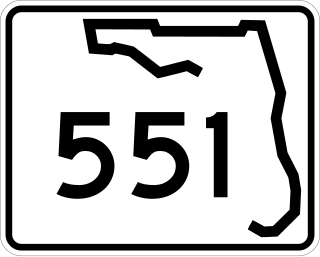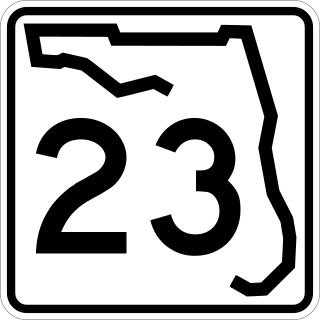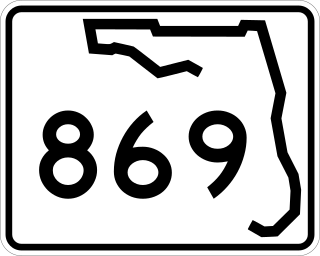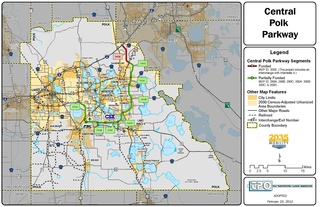
Interstate 4 (I-4) is an Interstate Highway located entirely within the US state of Florida, maintained by the Florida Department of Transportation (FDOT). Spanning 132.30 miles (212.92 km) along a generally southwest–northeast axis, I-4 is entirely concurrent with State Road 400 (SR 400). In the west, I-4 begins at an interchange with I-275 in Tampa. I-4 intersects with several major expressways as it traverses Central Florida, including US Highway 41 (US 41) in Tampa; US 301 near Riverview; I-75 near Brandon; US 98 in Lakeland; US 27 in unincorporated Davenport; US 192 in Celebration; Florida's Turnpike in Orlando; and US 17 and US 92 in multiple junctions. In the east, I-4 ends at an interchange with I-95 in Daytona Beach, while SR 400 continues for roughly another four miles (6.4 km) and ends at an intersection with US 1 on the city line of Daytona Beach and South Daytona.
Florida's Turnpike, designated as unsigned State Road 91, is a toll road in the U.S. state of Florida, maintained by Florida's Turnpike Enterprise (FTE). Spanning approximately 309 miles (497 km) along a northwest–southeast axis, the turnpike is in two sections. The SR 91 mainline runs roughly 265 miles (426 km), from its southern terminus at an interchange with Interstate 95 (I-95) in Miami Gardens to an interchange with I-75 in Wildwood at its northern terminus. The Homestead Extension of Florida's Turnpike continues from the southern end of the mainline for another 48 miles (77 km) to US Highway 1 in Florida City. The slogan for the road is "The Less Stressway". The mainline opened in stages between 1957 and 1964, while the extension was completed in 1974. The turnpike runs through Miami, Fort Lauderdale, and West Palm Beach, where it parallels I-95, and through Orlando, where it crosses I-4.

State Road 528 (SR 528), alternatively named the Martin Andersen Beachline Expressway, is a partially-tolled state road in the U.S. state of Florida; it is maintained by the Florida's Turnpike Enterprise (FTE), the Central Florida Expressway Authority (CFX), and the Florida Department of Transportation (FDOT). Spanning approximately 53 miles (85 km) along a west–east axis, it connects Interstate 4 (I-4) in Orlando with I-95, Titusville, and Cape Canaveral on the Space Coast. It passes close to the tourist areas of Orlando, including SeaWorld and Universal Orlando, and serves the north entrance to Orlando International Airport. Near its east end, it passes over the Intracoastal Waterway on the Emory L. Bennett Causeway, and ends at SR A1A and SR 401 near Port Canaveral.

The Central Florida Expressway Authority (CFX) is a highway authority responsible for construction, maintenance and operation of toll roads in six counties of Greater Orlando. It was created in 2014 to replace the Orlando–Orange County Expressway Authority (OOCEA), which only had authority in Orange County, and as of 2016 no roads outside that county have been added to the system. Other toll roads in the area are operated by Florida's Turnpike Enterprise and the Osceola County Expressway Authority; with the latter of which possibly merging into CFX some time after 2018.
State Road 417 (SR 417), also known as the Central Florida GreeneWay, Seminole County Expressway, Eastern Beltway and Orlando East Bypass, is a tolled limited-access state highway forming the eastern beltway around the city of Orlando, Florida, United States. It is owned and maintained by the Central Florida Expressway Authority (CFX) and Florida's Turnpike Enterprise. The CFX section was posthumously named after former Orlando Orange County Expressway Authority chairman Jim Greene.
State Road 408 (SR 408), officially named the Spessard L. Holland East–West Expressway, is a tolled expressway running east–west through Orlando, Florida, United States. It is owned and operated by the Central Florida Expressway Authority (CFX), except for the westernmost mile (1.5 km), which is owned by Florida's Turnpike Enterprise as a connection to Florida's Turnpike. The road runs from the Turnpike in Gotha, east through downtown Orlando, where it intersects with I-4, ending near SR 50 south of the University of Central Florida. The road is named for Spessard L. Holland.

State Road 551, locally known as Goldenrod Road and Palmetto Avenue, forms a north–south surface street bypass of Orlando to the east.

State Road 23 (SR 23), also known as the First Coast Expressway, is an outer bypass around the southwest quadrant of Jacksonville. As of 2018, the first phase has been built, linking the Middleburg area to Interstate 10 near Whitehouse.
State Road 429 (SR 429), also known as the Daniel Webster Western Beltway or Western Expressway south of US 441, and the Wekiva Parkway north of US 441, is a controlled-access toll road built and maintained by the Central Florida Expressway Authority (CFX), the Florida's Turnpike Enterprise, and the Florida Department of Transportation (FDOT). Its mainline currently extends 51.77 miles (83.32 km) from I-4 (SR 400) in Four Corners north to I-4 in Sanford. Control cities are Apopka and Tampa although the control cities for traffic at the entrances at US 441 and north are Orlando, Tampa, and Daytona Beach. SR 429 was originally planned as a western half of SR 417.

The Florida Department of Transportation (FDOT) is a decentralized agency charged with the establishment, maintenance, and regulation of public transportation in the state of Florida. The department was formed in 1969. It absorbed the powers of the State Road Department (SRD). The current Secretary of Transportation is Jared W. Perdue.
State Road 589 (SR 589), also known as the Veterans Expressway and Suncoast Parkway, is a north–south toll road near the Florida Gulf Coast. Maintained and operated by Florida's Turnpike Enterprise, this 68-mile (109 km) transportation corridor extends from State Road 60 in Tampa, north to State Road 44 near Lecanto. The Veterans Expressway was built to accommodate the increasing commuter traffic in the Tampa-St. Petersburg metropolitan area, with the Suncoast Parkway opening in 2001, extending from near the northern terminus of the Veterans Expressway to U.S. Route 98, with a possible northern extension to U.S. Route 19/U.S. Route 98 in Crystal River in Citrus County in the planning and development stages. As of February 28, 2022, Phase I of the extension is now open between US 98 and Florida State Road 44. Phase II, which would further extend the highway to County Road 486, is undergoing the design phase.
State Road 570 (SR 570), also known as the Polk Parkway, is a 24-mile (39 km), limited-access toll road which runs through Polk County, Florida. It is operated as part of Florida's Turnpike Enterprise system of limited-access expressways. The Polk Parkway mainly serves as a beltway around Lakeland forming a semicircle, which along with I-4 circumscribes most of the city limits of Lakeland.

The Dolphin East-West Expressway is a 15-mile-long (24 km), six-lane, divided controlled-access highway, with the westernmost 14 miles (23 km) as an all-electronic tollway signed as State Road 836, and the easternmost 1.292 miles (2.079 km) between Interstate 95 (I-95) and SR A1A cosigned as Interstate 395 (I-395). The road currently extends from just north of the intersection of Southwest 137th Avenue and U.S. Highway 41 (US 41) in Tamiami, eastward past the Homestead Extension of Florida's Turnpike (HEFT) and Miami International Airport, before intersecting I-95, becoming I-395 and ending at SR A1A in Miami at the west end of the MacArthur Causeway. The Dolphin Expressway is maintained and operated by the Miami-Dade Expressway Authority (MDX), while the I-395 section is maintained by the Florida Department of Transportation (FDOT). The Dolphin Expressway from the Palmetto Expressway to I-95 opened in 1969, with the I-395 section opening in 1971, the extension to the HEFT opening in 1974 and a second western extension opening in 2007.

Florida State Road 869 (SR 869) is a 24-mile-long (39 km) state road located in western and northern Broward County, acting as a de facto bypass of Fort Lauderdale as well as the northern coastal and southern parts of the county extending north from a junction of I-75 (SR 93), I-595 (SR 862) in Sunrise to Coral Springs where it heads eastward towards Florida's Turnpike and intersecting I-95 before terminating at Southwest 10th Avenue in Deerfield Beach. The 21.242-mile (34.186 km) section west of the Turnpike is known as the Sawgrass Expressway, a six-lane, limited-access, all-electronic toll road; the 2.745-mile (4.418 km) section east of the Turnpike is a surface street known as Southwest 10th Street. The expressway opened in 1986 and was added to Florida's Turnpike Enterprise in 1990. The at-grade section east of the Turnpike is maintained by FDOT.
The Miami-Dade Expressway Authority (MDX) is an independent agency created in December 1994 by the State of Florida and the Miami-Dade County Commission. Since 1997 MDX has operated and maintained five expressways formerly operated by the Florida Department of Transportation (FDOT):
The Homestead Extension of Florida's Turnpike (HEFT), designated as unsigned State Road 821 (SR 821), is the southern extension of Florida's Turnpike, a toll road in the U.S. state of Florida maintained by Florida's Turnpike Enterprise (FTE). Spanning approximately 48 miles (77 km) along a north–south axis, it supplements the 265-mile (426 km) mainline to form the complete 309-mile (497 km) turnpike. The extension begins at its southern terminus at U.S. Route 1 (US 1) in Florida City, and transitions into the SR 91 mainline in Miramar at its northern end. Despite their designations as different state roads, the mainline and the extension are continuous in their exit numbering.

Interstate 95 (I-95) is the main Interstate Highway of Florida's Atlantic Coast. It begins at a partial interchange with US Highway 1 (US 1) just south of downtown Miami and heads north through Jacksonville, and to the Georgia state line at the St. Marys River near Becker. The route also passes through the cities of Fort Lauderdale, West Palm Beach, Port St. Lucie, Titusville, and Daytona Beach.

Interstate 75 (I-75) is a part of the Interstate Highway System that runs from the Hialeah–Miami Lakes border, a few miles northwest of Miami, to Sault Ste. Marie in the Upper Peninsula of Michigan. I-75 begins its national northward journey near Miami, running along the western parts of the Miami metropolitan area before traveling westward across Alligator Alley, resuming its northward direction in Naples, running along Florida's Gulf Coast, and passing the cities of Fort Myers, Punta Gorda, Venice, and Sarasota. The freeway passes through the Tampa Bay area before turning inward toward Ocala, Gainesville, and Lake City before leaving the state and entering Georgia. I-75 runs for 471 miles (758 km) in Florida, making it the longest Interstate in the state and also the longest in any state east of the Mississippi River. The Interstate's speed limit is 70 mph (110 km/h) for its entire length in Florida.

The Central Polk Parkway, also known as State Road 570B (SR 570B), is a proposed toll road in Polk County, Florida. The proposed road is actually two separate roads—called legs by the Florida Department of Transportation (FDOT). The western segment will connect the Polk Parkway with SR 60 between Bartow and Lake Wales. The eastern leg will start a few miles east of SR 60 and run north, parallel to US Highway 27 (US 27), and terminate at Interstate 4 (I-4) north of Davenport. The most recent, and viable, proposed routing will connect the two legs together near the CSX Intermodal Facility south of Wahneta. In December 2015, FDOT announced the cancellation of any further work on the project, citing insufficient funds and low traffic volume. The project continued to have the support of the local business community and local politicians, however, and it was revived in 2018.











